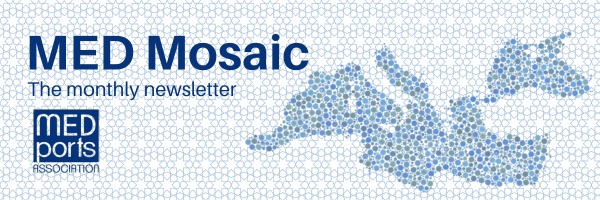MED MOSAIC

Issue 6
HOT SEAT:
Interview with Sergi Sauri – Director of CENIT
Navigating the Seas of Change: EU ETS Impact on Southern Mediterranean Ports and Maritime Strategies
- Let’s start with the first point, what is the EU Emissions Trade System?
From an economic perspective, we have two ways of encouraging the reduction of emissions: one involves making the polluter pay for their pollution, while the other relies on emissions markets. In the latter, an emissions market is established, allowing companies that pollute less to sell their emission rights to those that pollute more. In this case, the total volume of emissions stays the same. In fact, the EU Emissions Trade System (EU ETS) that will apply to the maritime sector from January 2024, is based on the principle of paying for pollution. The idea is that ships sailing in European waters will pay for the CO2 emissions they emit. This is one of the measures within the European Commission’s Fit for 55 package aimed at decarbonizing the transport sector.
- Will it have a positive effect?
In theory, yes. This measure will provide incentives for shipping companies to reduce their emissions, which is the intended goal, and therefore pay less ETS tax. Hopefully this will be the case sooner or later. For now, these companies have already announced an increase in their prices. The problem is that there are other incentives: it is very likely that shipping companies will restructure their operations to avoid paying part of this tax and this will cause some ship emissions to fall outside the scope of the ETS system.
- Can you explain this in more detail?
Initially it was thought that shipping companies would call at a port before reaching the European Union to minimize their ETS taxes. By doing this, they would only pay 50% of the emissions for a much shorter voyage compared to a journey made without any stops and arriving directly in Europe from Asia or after crossing the Atlantic. To avoid this, the European Commission introduced the concept of a “transparent port”. In this context, a call at such a non-European port would not be counted as a stop, it would be considered “transparent,”. The tax paid would be the same as if the ship had come directly from Asia or the other side of the Atlantic. However, there is another way to avoid the tax: by reconfiguring the routes.
- How?
By transferring hub operations to North African ports. For example, a ship coming from Southeast Asia would unload at Port Said and from there, smaller feeder ships would distribution the cargo to European ports. The ship coming from Southeast Asia would pay nothing in emissions tax and the ship traveling to Europe would pay much less than if it had come directly from Asia or America, for example. This is a measure that will benefit North African ports. For certain, we will see an increase in transshipment operations and infrastructure investment in these ports in the coming years.
We recently analyzed the impact of the ETS on several maritime routes, and on some of them an annual saving of € 30 M per year could be achieved in the short term by implementing this reconfiguration of maritime routes. These savings would be significant for shipping companies.
- Surely the European Commission is aware of these effects, do you consider the implementation of the ETS to be an appropriate measure?
It is appropriate and it will certainly contribute to the development and implementation of measures to reduce emissions from the maritime sector. In fact, some shipping companies have already made announcements regarding these measures. However, the way the regulation is currently drafted there is a danger that a significant portion of CO2 emissions will remain outside the scope of the ETS system, which is exactly what the measure is intended to avoid. The way the EU ETS is currently drafted is not entirely effective.